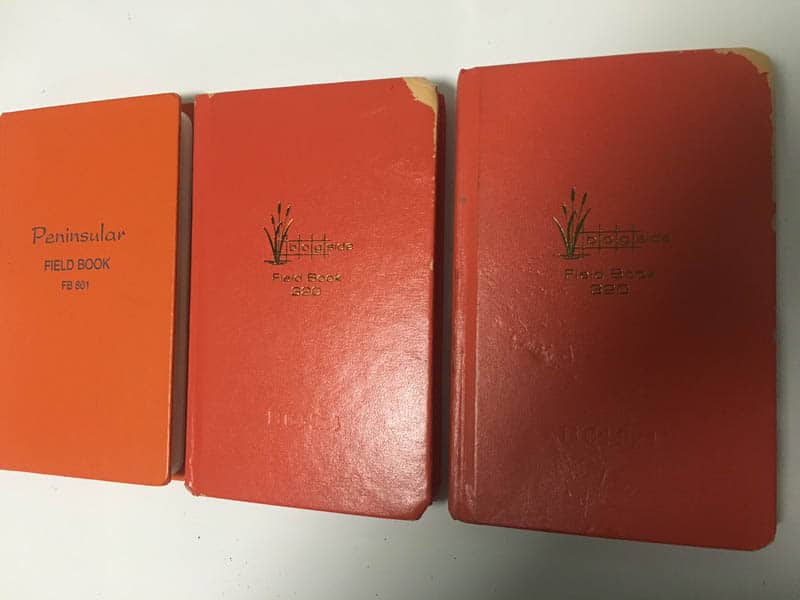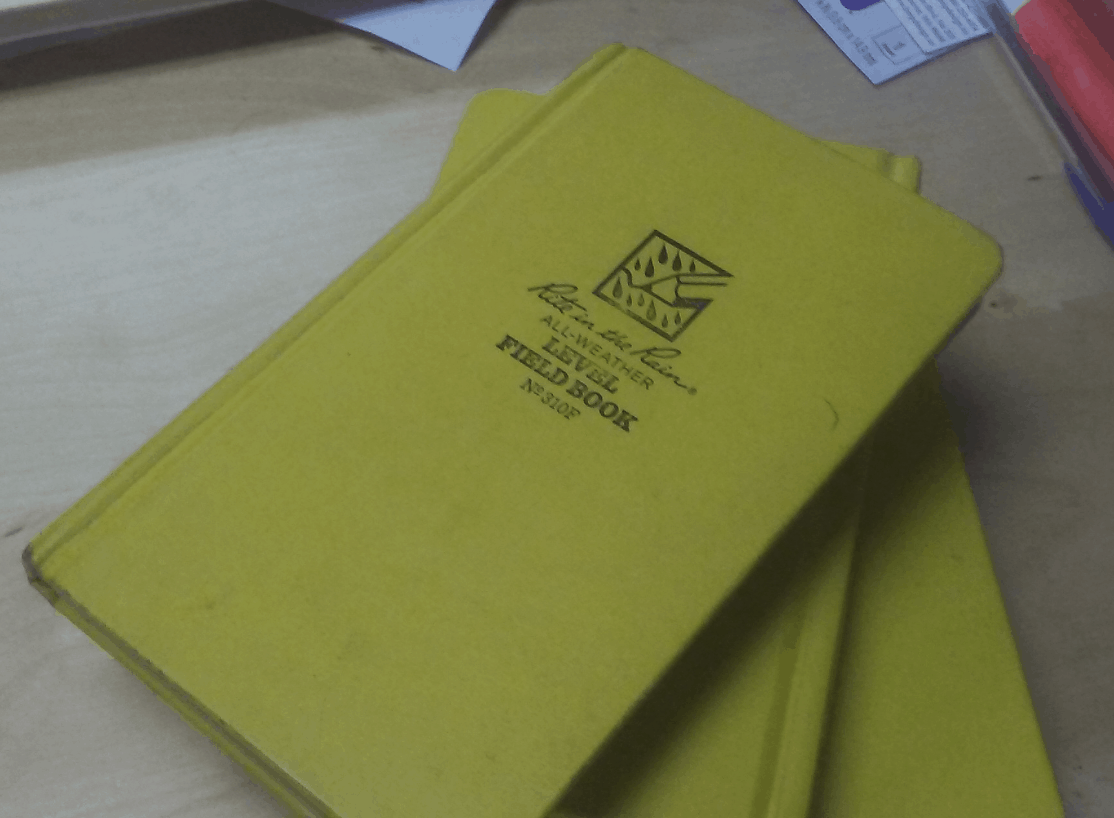As this photo shows, unfortunately the covering on the Bogside #320 field books is inferior to that used on the Peninsular FB 801, now discontinued, that I thought they would replace. All of the field books have been carried in the inside pocket of my vest. It would be nice to convince the folks at Bogside Publishing Company to use a more durable covering, even if it means raising the price a bit.
I find that the yellow book is easier to find on my desk or on the ground. Not that I am a fumbling mess or anything.
Mark Mayer, post: 433354, member: 424 wrote: These Rite-in-the-Rains have been through the vest pocket mill. Plus they've been rained on numerous times and thoroughly soaked at least once or twice.
I'm currently carefully drying the pages of a field book that i got caught in the rain with yesterday. Kinda wish i was using one of these.
For years I have carried the LB801 (Level book) from Peninsular for use as a journal. It is small enough to fit in the back pocket of my jeans. I've had a couple where the cover separated from the pages but a little packing tape held it until the book was full.
Andy
For those of us up north, Rite in the Rain books stand up well not only to rain and snow, but also to the squishy biomass of mosquito/no-see-um/white socks guts and skeeter-borne human blood that is entered into the permanent record every time the book is closed.
I have no clear memory of when I first discovered Rite in the Rain. I first used the loose leaf pages, then later the bound books. They are not cheap, but they do last and last and last.
even when it is as dry as a popcorn fart I use them, sweat is also an obsticle
Mark Mayer, post: 433354, member: 424 wrote: These Rite-in-the-Rains have been through the vest pocket mill. Plus they've been rained on numerous times and thoroughly soaked at least once or twice.
I think that I bought one Rite-in-the-Rain fieldbook once, but as best I can recall, the tooth of the paper was a bit problematic. I'd think that for a couple of extra bucks the folks at Bogside Publishing could cover their field books with something a good bit sturdier. There pretty much have to be standard cover fabrics sold to book binders for all sorts of purpposes, fabrics that can be bought off the shelf with zero R & D effort.
Kent McMillan, post: 433425, member: 3 wrote: the tooth of the paper was a bit problematic.
The paper is a bit rough. Switching to an H pencil may improve your experience with it.
Mark Mayer, post: 433429, member: 424 wrote: The paper is a bit rough. Switching to an H pencil may improve your experience with it.
I use H leads. Maybe 2H are needed. It seems to me that erasures on sketches were also a problem with the Rite-in-the-Rain fieldbooks, but I may be misremembering that detail.
Jim Frame, post: 433428, member: 10 wrote: The book below is pretty typical for me: it spent about a year in my inside vest pocket. The cover fabric is smudged here and there, but still intact.
Okay, but knowing the Frame Economic Model, may I assume that was a field book purchased on eBay that you then had to erase various entries from that the previous owner had made? Is the Leonardo da Vinci method of overwriting at different angles really all that economical when you factor in the time needed to actually read what was overwritten? :>
I can't erase in my rite in rain books. Pretty annoying. Good books otherwise.
Shawn Billings, post: 433436, member: 6521 wrote: I can't erase in my rite in rain books. Pretty annoying. Good books otherwise.
I was taught from the beginning that erasures in a field book were a big no-no. Strikethroughs and corrections were appropriate. Of course the head of the Surveying Department where I went to school wanted no less than 6H lead too. When you handed on a field book he was likely to lick his thumb and wipe it across the page. If it smeared you received a stern "talking to".
Andy
Andy Bruner, post: 433461, member: 1123 wrote: I was taught from the beginning that erasures in a field book were a big no-no.
Erasures on sketches are always acceptable as long as it's a clean erasure, not a smudge job. Otherwise, the alternative is to void the entire sketch and start again, which is usually not a very good choice.






